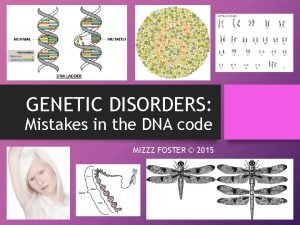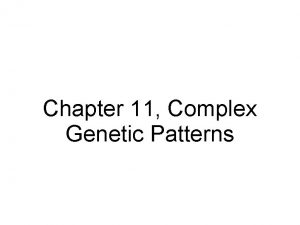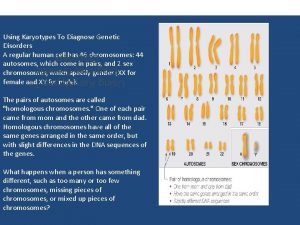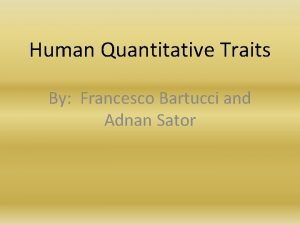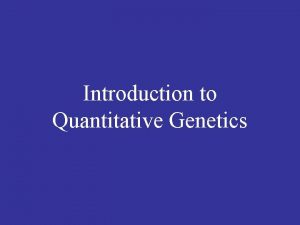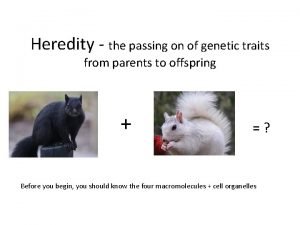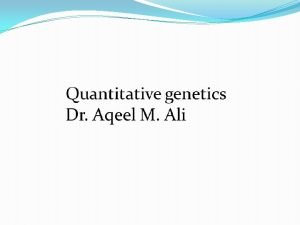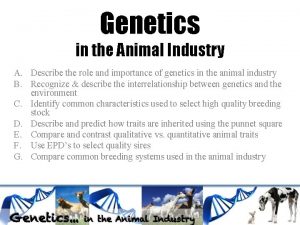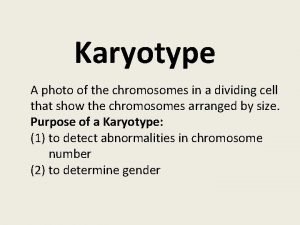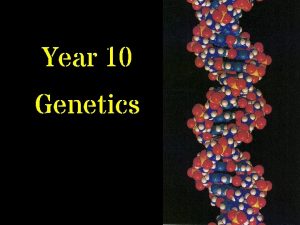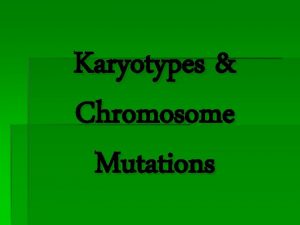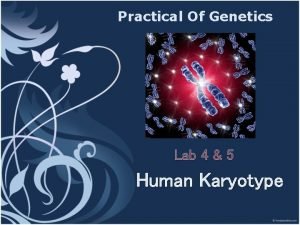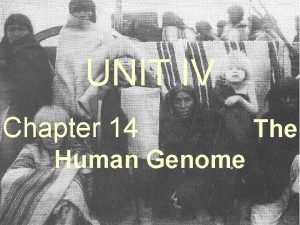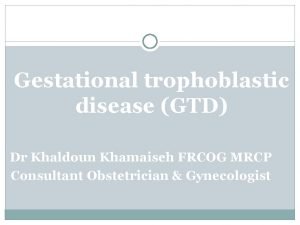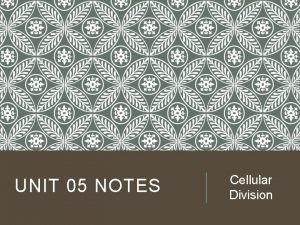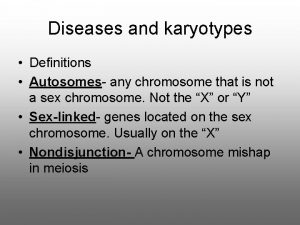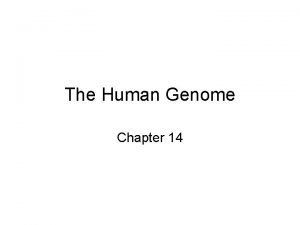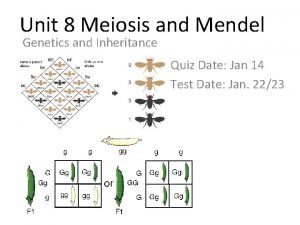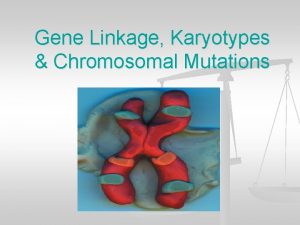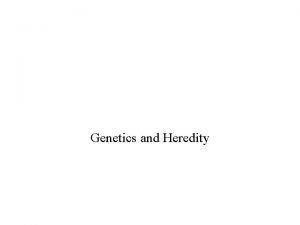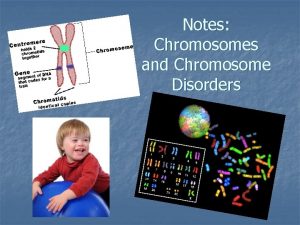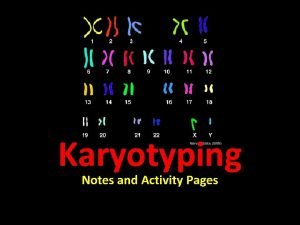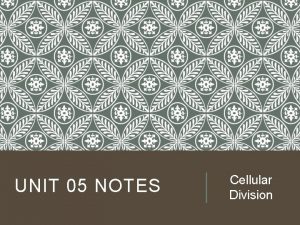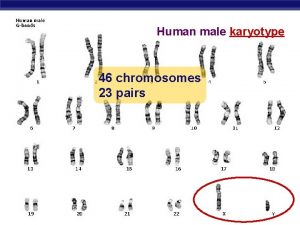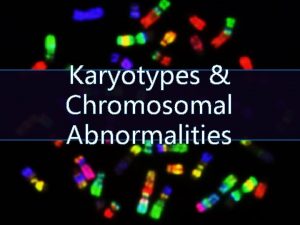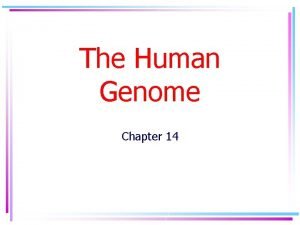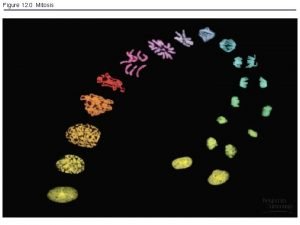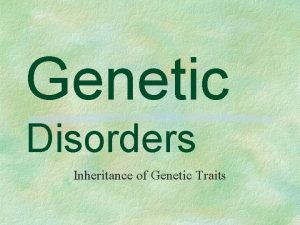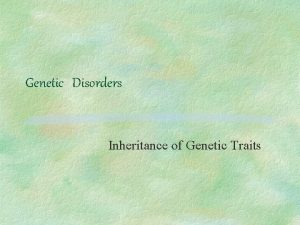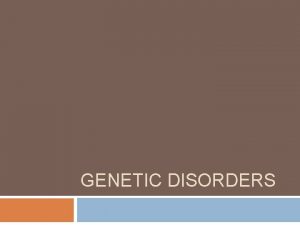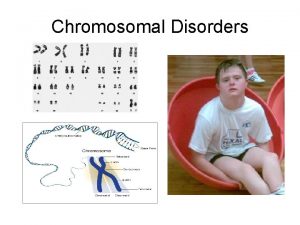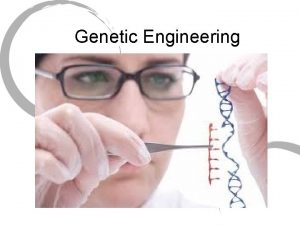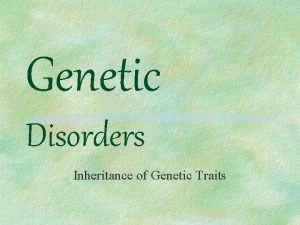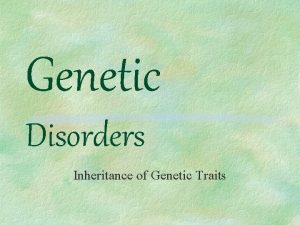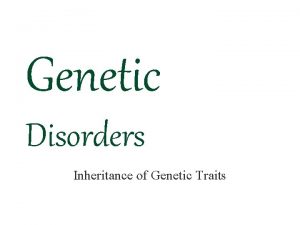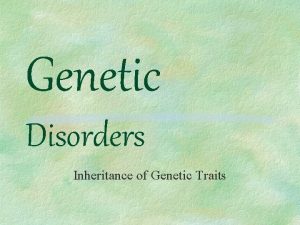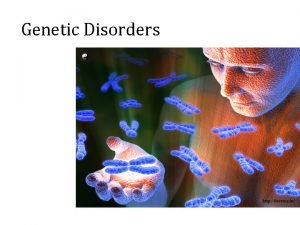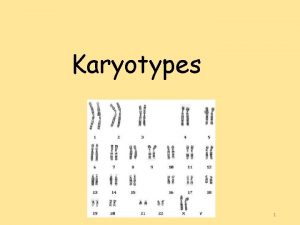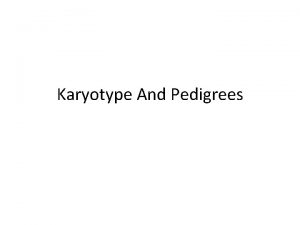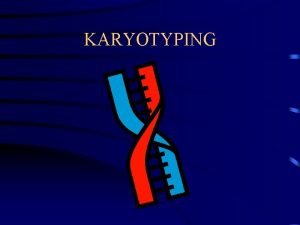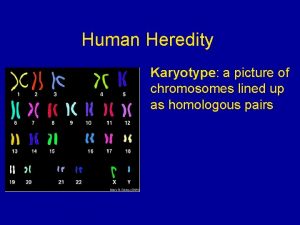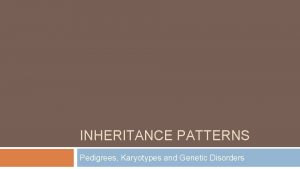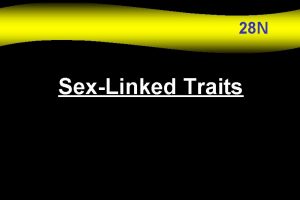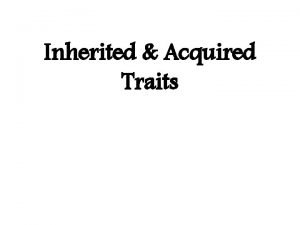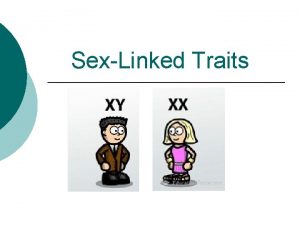Genetic Disorders Inheritance of Genetic Traits Karyotype preparation












































- Slides: 44

Genetic Disorders Inheritance of Genetic Traits

Karyotype preparation and analysis This is a photograph of the 46 human chromosomes in a somatic cell, arrested in metphase. Can you see that they are duplicated sister chromatids?




Karyotype of a boy with Down Syndrome:

Down’s Syndrome § Caused by nondisjunction of the 21 st chromosome. § This means that the individual has a trisomy (3 – 2 lst chromosomes).


Symptoms of Down Syndrome § § § Upward slant to eyes. Small ears that fold over at the top. Small, flattened nose. Small mouth, making tongue appear large. Short neck. Small hands with short fingers.

Symptoms of Down Syndrome § § § Low muscle tone. Single deep crease across center of palm. Looseness of joints. Small skin folds at the inner corners of the eyes. Excessive space between first and second toe. In addition, down syndrome always involves some degree of mental retardation, from mild to severe. In most cases, the mental retardation is mild to moderate.

Kleinfelter’s syndrome (or Klinefleter’s) § Disorder occurring due to nondisjunction of the X chromosome. § The Sperm containing both X and Y combines with an egg containing the X, results in a male child. § The egg may contribute the extra X chromosome.

XXY § Males with some development of breast tissue normally seen in females. § Little body hair is present, and such person are typically tall, have small testes. § Infertility results from absent sperm. § Evidence of mental retardation may or may not be present.


§ Klinefleter’s

Turner’s Syndrome

Turner’s § Turner syndrome is associated with underdeveloped ovaries, short stature, webbed, and is only in women. § Bull neck, and broad chest. Individuals are sterile, and lack expected secondary sexual characteristics. § Mental retardation typically not evident. § Chromosomal or monogenic?

Patau Syndrome serious eye, brain, circulatory defects as well as cleft palate. 1: 5000 live births. Children rarely live more than a few months.

Edward’s Syndrome almost every organ system affected 1: 10, 000 live births. Children with full Trisomy 18 generally do not live more than a few months.

B. 47, XYY males: Individuals are somewhat taller than average and often have below normal intelligence. At one time (~1970 s), it was thought that these men were likely to be criminally aggressive, but this hypothesis has been disproven over time.

Trisomy X: 47, XXX females. 1: 1000 live births - healthy and fertile usually cannot be distinguished from normal female except by karyotype


Mutations Change in the DNA that leads to a genetic change Can be beneficial or harmful Lethal means deadly

Sickle Cell Anemia § Crescent shaped red blood cells § Autosomal recessive § More common among african americans § Nn (carrier is more resistant to malaria)

Cystic Fibrosis (CF) § Monogenic § Cause: deletion of only 3 bases on chromosome 7 § Fluid in lungs, potential respiratory failure § Common among Caucasians… 1 in 25 are carriers l l Dominant or Recessive Autosomal recessive

Tay-Sachs disease § Monogenic, autosomal recessive § Central nervous system degrades, ultimately causing death. § Most common among people of Jewish, eastern Europe descent.

Muscular Dystrophy § What Is Muscular Dystrophy? Muscular dystrophy is a disease in which the muscles of the body get weaker and slowly stop working because of a lack of a certain protein § Duchenne’s Muscular Dystropy x-linked recessive

Hemophilia § Hemophilia is the oldest known hereditary bleeding disorder. § Caused by a recessive gene on the X chromosome. § There about 20, 000 hemophilia patients in the United States. § One can bleed to death with small cuts.

Huntington’s Disease § Huntington's disease (HD) is an inherited, degenerative brain disorder which results in an eventual loss of both mental and physical control. The disease is also known as Huntington's chorea. Chorea means "dance-like movements" and refers to the uncontrolled motions often associated with the disease.



Phenylketonuria or PKU is a metabolic disorder that results when the PKU gene is inherited from both parents (recessive or dominant? Monogenic or chromosomal? ) Caused by a deficiency of an enzyme which is necessary for proper metabolism of an amino acid called phenylalanine.

PKU § Phenylalanine is an essential amino acid and is found in nearly all foods which contain protein, dairy products, nuts, beans, tofu… etc. § A low protein diet must be followed. § Brain damage can result if the diet is not followed causing mental retardation…and mousy body odor (phenylacetic acid is in sweat).

PKU

Phenylalanine. Free diet §

Color Blindness § Cause: x-linked recessive § 1/10 males have, 1/100 females have. Why the difference? § Individuals are unable to distinguish shades of red-green. § Are you color blind?


Albinism § Patients are unable to produce skin or eye pigments, and thus are light-sensitive § Autosomal recessive l Therefore, is it monogenic or chromosomal?

Achondroplasia (a. k. a. dwarfism) § Monogenic, autosomal l l Carriers express genes, therefore, is it dominant or recessive? There is also a disease called gigantism (Andre the Giant)

The very tragic disease… hairy ears Y-linked trait, which are rare § symptoms…hairy ears § Only 1 cure known….


ALS (Amyotrophic Lateral Sclerosis, or Lou Gehrig’s disease)

§ the disease strikes people between the ages of 40 and 70, and as many as 30, 000 Americans have the disease at any given time § This monogenic mutation is believed to make a defective protein that is toxic to motor nerve cells. § A common first symptom is a painless weakness in a hand, foot, arm or leg, other early symptoms include speech swallowing or walking difficulty

Diabetes § Disease in which the body does not produce or properly use insulin. l Insulin is a hormone that is needed to convert sugar, starches, and other food into energy needed for daily life. § Genetic mutation can lead to Type 1 diabetes, but no one sure if relative to a specific gene

Diabetes § Type 1 reveals itself in childhood, Type 2 can be made worse from excessive lifestyle § Warning signs l l l Extreme thirst Blurry vision from time to time Frequent urination Unusual fatigue or drowsiness Unexplained weight loss Diabetes is the leading cause of kidney failure, blindness, and amputation in adults, and can also lead to heart disease.
 Genetic disorders
Genetic disorders Chapter 11 genetic disorders concept mapping
Chapter 11 genetic disorders concept mapping Dominant vs recessive genetic disorders
Dominant vs recessive genetic disorders Using karyotypes to diagnose genetic disorders
Using karyotypes to diagnose genetic disorders Quantitative and qualitative traits
Quantitative and qualitative traits Inheritance of quantitative traits
Inheritance of quantitative traits Dominant genetic variance
Dominant genetic variance Genetic drift vs gene flow
Genetic drift vs gene flow Specation
Specation Genetic drift vs genetic flow
Genetic drift vs genetic flow Genetic programming vs genetic algorithm
Genetic programming vs genetic algorithm Genetic programming vs genetic algorithm
Genetic programming vs genetic algorithm Human genetic traits
Human genetic traits Austrian genetic traits
Austrian genetic traits Traits
Traits Qualitative traits vs quantitative traits
Qualitative traits vs quantitative traits Qualitative traits vs quantitative traits
Qualitative traits vs quantitative traits Karyotype klinefelter syndrome
Karyotype klinefelter syndrome Whats a karyotype
Whats a karyotype Whats a karyotype
Whats a karyotype Gender punnett square
Gender punnett square Karyotype mutations
Karyotype mutations Karyotype
Karyotype How do you know if a karyotype is male or female
How do you know if a karyotype is male or female Acrocentric chromosome
Acrocentric chromosome Trisomy 21
Trisomy 21 Karyotype
Karyotype Figo prognostic scoring system gtn
Figo prognostic scoring system gtn How many chromosomes do humans have
How many chromosomes do humans have Female with klinefelter syndrome karyotype
Female with klinefelter syndrome karyotype Sindrome cri du chat
Sindrome cri du chat Disorder
Disorder Color blindness karyotype
Color blindness karyotype Practice haploid v. diploid answer key
Practice haploid v. diploid answer key Chromosome mutation
Chromosome mutation Hemophilia karyotype picture
Hemophilia karyotype picture What is characteristics
What is characteristics Chromosome 18 baby pictures
Chromosome 18 baby pictures Klienfelters syndrome have karyotype
Klienfelters syndrome have karyotype Extending mendelian genetics answer key
Extending mendelian genetics answer key Karyotype
Karyotype Karyotype of a male
Karyotype of a male Karyotyping
Karyotyping Chapter 14 the human genome making karyotypes answer key
Chapter 14 the human genome making karyotypes answer key Female karyotype
Female karyotype
